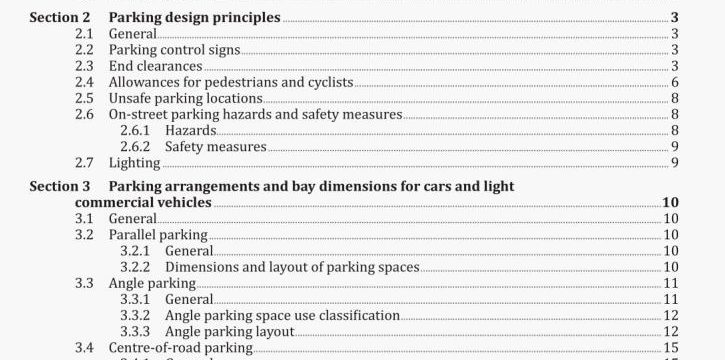AS 2890.5-2020 pdf download.Parking facilities
Part 5 : On-street parking.
Taxis (see Clause 4.3).
(c) Motorcycles (see Clause 4.4).
People with disabilities (see Clause 4.5).
(e) Bicycles (refer to AS 2890.3).
4.2 Large vehicles
4.2.1 General provisions
The long-term kerbside parking of large vehicles (other than light commercial vehicles) on-street is generally discouraged. often by law. Wherever there Is a need for large vehicles to be parked other than on private property, a parking area physically separated or otherwise remote from the through roadway should be sought. For the requirements of such a facility, refer to AS 2890.2.
In the event that limited kerbside parking is required, parallel parking is the only practicable configuration. Spaces need to be made long enough to accommodate the vehicle and the necessary manoeuvre space for parking and unparking. On-street angle parking for large vehicles is almost never practicable.
4.2.2 Loading zones
Short-term stopping for purposes of loading or unloading goods vehicles is provided for by means of loading zones. They should be provided where it is necessary to allow vehicles to stand for the picking up or setting down of goods. They should allow stopping parallel to the kerb and should have a length which will accommodate the vehicles which normally use them. Bearing in mind the need to locate loading zones close to the premises being served, consideration should be given to placing loading zones at the beginning or end of a section of parking, rather than in the middle, to reduce the need for awkward vehicle manoeuvring, especially the reversing of large vehicles.
4.2.3 Truck zones
In some jurisdictions short-term stopping of heavy goods vehicles is catered for by use of truck zones. The usage and legal requirements relating to truck zones are similar to those for loading zones, except that time limits may not apply provided the vehicle is loading or unloading.
4.2.4 Parking space width and length
The minimum width of parallel parking spaces for various road speed limits is given in Table 4.1.
The length of the space shall allow for the length of the design vehicle, the number of such vehicles, and their draw in and draw out requirements.
4.3 Taxi stands and feeder stands
It is desirable that taxis stand parallel to the kerb, lacing in the direction of the main traffic stream so that waiting taxis may progress from the tail of the taxi queue to the head. Minimum length of taxi stands should be (5.4 n + 1.0) metres, where n is the number of taxis to be accommodated.
Consideration should be given to accommodate accessible taxis including space length and kerb ramps.
Should there be a demand for greater allocation of space at any particular location, the main stands should be fed from feeder stands established at a reasonable distance from the main stand. The feeder stand should be so placed that the lead taxi can observe when a space becomes vacant at the main stand. A feeder stand may feed one or more main stands.
4.4 Motorcycles
Providing motorcycle parking reduces the need for motorcycles to park in car spaces improving the efficient use of the available space. Conversion of car parking spaces as illustrated in Figure 4.1 can provide the required facilities.
Where motorcycle parking spaces are marked the size shall be 1.0 m wide by 2.0 m long. This applies to
both parallel and angle parking.
NOTE I See parking dimension recommendations in IHIE Guidelines for Motorcycling.
NOTE 2 Motorcycle parking may be more efficient if individual spaces are not marked allowing more motorcycles to use the available space.
NOTE 3 Where the space available for car parking would allow for oversize car spaces an alternative option of using that space for motorcycle parking should be considered.
Surface grades should be less than I in 20 (5 %) to avoid parked motorcycle capsizing.
To support the weight of the motorcycle, the surface needs to be capable of carrying a load of 10 kg/cm2 to avoid penetration by the stand.
Small areas that would otherwise be unused for car parking should be used for motorcycle parking. Consideration should be given to access path to these spaces including kerb ramps and path width.
Where sight distance for road users is a factor, for example, before and after intersections and pedestrian crossings, motorcycle parking in preference to carparking should be provided as both drivers and pedestrians can see over the parked motorcycles. This concept also works for driveways and other entrances where vehicles regularly cross the footpath or bicycle path.
Motorcycles parked on the footpath should be no closer than 2 m to the building line. 600 mm to the kerb and within 1 m of essential services.AS 2890.5-2020 pdf download.On-street parking
On-street parking
